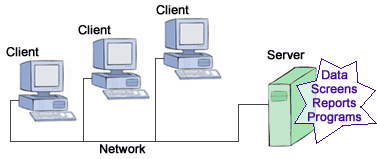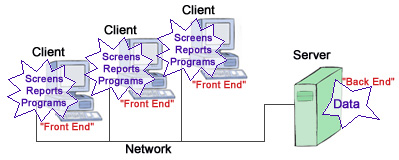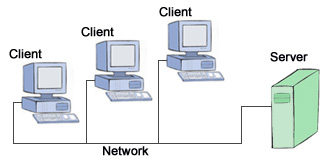 |
 |
|
|
|
|
|
|
|
|
|
|
|
|
|
|
|
|
 |
| Click below to see some references: |
 |
 |
 |
 |
 |
Databases: Client-Server ArchitectureOn a network, one extra-fast, extra-powerful computer is normally a "server". The company database is stored on the server, and all the PCs on the network (called "clients") request information from it as needed.
However, even though the hardware is set up properly, it doesn't mean that the database is.
|
 |
Following is what happens in this setup when a user prints a report:
Division of work - One centralized shared database
(a lot of green is bad!)
|
This creates a burden on:
| The server: | since the server's CPU does all the report formatting, totals calculations, etc., and |
| The network: | since (1) instead of sending just the raw data, it's sending a fully formatted report, which is considerably more information; and (2) there's much more back-and-forth activity |
Bear in mind that if multiple users are accessing the server simultaneously, poor speed is likely to result. The idea is to move as much processing as possible to the clients, since today's PC's have plenty of computing power, and to have the server do as little as possible. This is achieved as follows:
Better setup: Split database
The proper design is to "split" the database into two:
| Name | Description | Location | |
| "Front end" | Programs, Forms (screens) and Reports | Client (individual PC) | |
| "Back end" | Data only | Server |
 |
Note how the server now hardly does anything, and there's only one interaction between the individual PC and the server:
Division of work - Split database
|
This design, or "architecture", results in a much faster system, since:
- The Server is only selecting raw information and not doing calculations or formatting;
- Much less information is sent over the network,
- There are fewer requests made between the Client and the Server, and
- The Client does all the formatting and calculations.
Disadvantage of Client-Server database setup
This approach does result in some additional effort on the part of the network administrator, since every time changes are made to programs (screens or reports), a new copy of the "front end" has to be copied to all the Clients. It's well worth it, however, because of increased performance (unless your database is very small and your screens and reports are very simple).
Also, with increasingly fast networks and servers, this isn't as great an issue as it once was.
|
Copyright © Rachel Peck 2003 - all rights reserved
|



